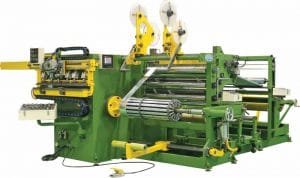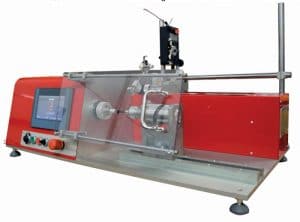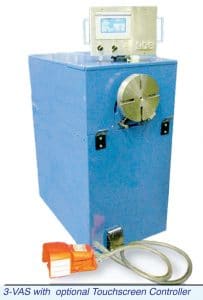 From multi-speed machines to medium, large and extra-large variants, coil winding machines come in diverse types and categories, performing a wide range of functions.
From multi-speed machines to medium, large and extra-large variants, coil winding machines come in diverse types and categories, performing a wide range of functions.
By Baishakhi Dutta
In electronics manufacturing, coil winding refers to the methods and techniques of winding an electric conductor (insulated wire or braid wire) to a coil. A machine designed and developed to perform these winding operations to enhance economic efficiency, repeat accuracy, production quality, etc, is known as a winding machine.
Coil winding is a serious business. It is not just about winding a specified number of turns on a plastic bobbin, but also about winding these turns in a specific manner and according to a definite layout. The kind of winding that needs to be done—layer wound (spatial or close) or bank winding – varies depending on the application. And at high frequencies, even more parameters need to be considered.
The various types of machinery available
There are many categories of winding machines. One of these include the air core winding machines, which contain spring-type coils with a predefined number of turns and mounting methods – horizontal or vertical. They also include antenna coils for telecom applications. These machines are usually rectangular or square shaped.
Another machine can wind on a coil former or ferrite core. There are specialised winding machines as well, which are used for winding toroidal transformers and small common mode choke coils.
Apart from the above-mentioned types, further classification of winding machines depends upon the following factors.
Type of material being wound: Based on the material, there are several categories of devices like wire winding machines, tape/insulation winding machines, yarn winding machines, foil winding machines, and so on.
Shape of bobbin on which winding has to be done: There are two categories of machines that fall under this classification.
| Automatic machines | Manual machines |
| Production output is high | Production output is low |
| Repeat accuracy is high | Repeat accuracy is low |
| Proper tension can be maintained | Proper tension cannot be maintained |
| Not time consuming | Highly time consuming |
| Requires high capital investments | Requires more manpower |
| Low skilled manpower required | High skilled manpower required |
Toroidal winding machines
These machines can be further classified into four categories based on the winding techniques used.
- Slider type toroidal winding machines
- Belt type toroidal winding machines
- Gear type toroidal winding machines
- Pull type toroidal winding machines
Linear winding machines
These machines, too, can be classified into two broad categories:
- Table-top winding machines (semi-automatic)
- Fully automatic winding machines
With the fully automatic machines, winding, bobbin loading, bobbin unloading, wire gripping, wire cutting, twisting, final taping and inter-layer insulation can be done automatically, once the parameters are programmed into the machine. All these classifications make it evident that the type of winding machine selected will vary based on one’s requirements.
Winding may be done in two ways—layer winding or sectional winding. Winding machines come with taping attachments, with which inter-winding insulation using tapes is also possible on the same winding machine.
Why choose automatic machines rather than manual versions?
“There are not many manual machines any more. With the advent of technology, more automated machinery is in use,” says Scott Heran, co-owner, ACE Equipment Company, about the current market scenario.
“A manual winding machine usually has a core on a spindle and the operator feeds wire, rope, or other material onto the core. The operator needs to control the speed of the spindle and then feed the material by hand, thereby guiding it to control the tension and load pattern. These simple machines may be of a bench-top size or large standalone winders,” explains Roland West, managing director, Ingrid West Machinery Ltd.
“Electrical or automatic machines ensure low leakage inductance and a perfect turn ratio. All these parameters are very critical for the quality of SMPS transformers. These machines also ensure production efficiencies and a better quality of winding. In manual machines, the number of turns can’t be controlled and the winding pitch can also be disturbed, while in electrical machines, the number of turns and the winding pitch can be programmed,” adds West.
“The coil winding industry is also undergoing advances in terms of upgrading technology for better productivity and improved quality. Automation is one such advancement, wherein the line will be customised for each product/customer. Depending on the process and productivity requirements, high volume production lines can be successfully installed. This has drastically reduced the manpower required compared to conventional processes and even increased productivity. The general coil assembly line consists of several functional modules, such as automatic feeding, plus winding, plus taping, plus soldering, plus automatic cutting. In this way, the coil line can be modularised according to particular requirements.”
—Soni Saran Singh, executive director, NMTronics (India) Pvt Ltd
The importance of tension in coil winding machines
The tensioner of the machine ensures proper feeding of the wire. A loose wire increases the winding build which results in high leakage inductance, high resistance, high voltage failure and there is even the possibility of insulation damage. “Proper tension is critical to winding a good coil. Inadequate tension results in coils that are malformed, too large, and cause problems with coil insertion,” says Heran.
Consistent tension needs to be applied to the wire during the coil winding process. The consistency and quality of the tension applied depends on the shape of the wire. In a round coil, the tension remains consistent during one revolution. However, in the rectangular coils, the wire tension is not consistent and experiences fluctuations. These fluctuations are due to the rapidly changing wire path length. The varying tension may affect the operation of the shaft, and produce excessive forces, which may cause machine vibrations and non-uniform coil winding. When this happens, the rectification process is extremely time consuming, and it also may affect productivity.
Today, various types of tensioners are available in the market, which help maintain constant wire tension during high-speed coil winding processes.

Benefits of wire tension control devices (tensioners)
Tension control devices are classified into three main categories —mechanical, electronic and servo controlled (closed loop). The servo controlled devices provide the best response time. Although the features of these devices may vary across brands, there are certain benefits that they offer. Some of these benefits are summarised below.
- Help to achieve quality standards: The rising demand for tight tolerance is driving the manufacturing industry to adopt stricter coil winding tension control measures. They are depending on automated tension control devices to meet the rising quality expectations.
- Versatility: Many computerised control devices (servo controlled) are designed to allow parameter changes to suit the diameter range. The tension of the wire can be set as per the requirement.
- Help to maintain process efficiency: Most of the wire tension control devices are designed to match the maximum machine speed of the winding machine, which helps to minimise wire breakages.
Today, you can find wire tension control devices in various designs, sizes and specifications. However, it is advisable to approach a coil winding expert to know more about various types of wire tension control devices, and their benefits, before making a big investment.
Latest innovations and technological advances
“Automatic machines which carry out all operations like winding, taping, termination, tinning, core insertion and even testing the transformer, are available in the market. These are interconnected machines with the auto transfer mechanism. These machines require high investments and production volumes,” says Anil Batra, managing director, ITP Electronics Pvt Ltd.
According to Heran, “The latest technological advancement is the new drive systems that are available today. These drives provide for many more control features in coil winding.”
“Technology has advanced from those simple hand winding machines that have a good de-reeler for fine wires (suitable only to make samples), to CNC machines into which the complete winding details are fed. These machines can auto wrap, auto wind, auto eject, wind multiple spindles at very high speed—all for making a particular type of coil in very large quantities. Individual requirements determine what kind of winding machine to go for,” says Nishant Jain, marketing head, Anant Enterprises. “Fully automatic pull winding machines and the invention of BLDC motors are the dominating trends in the market at present,” adds Raghunath C., managing director, Electromech.
Points to consider before making a purchase decision
“Select the right machine configuration based on the process and productivity desired. The versatility of the machine – when it comes to handling different products within the machine range—is also important,” says Soni Saran Singh, executive director, NMTronics (India) Pvt Ltd.
“It is all about quality and after sales service. Work with companies whose service teams will be there for you if you have questions or problems after the purchase,” adds Heran. “Quantity and product type are key factors. In case budget is not a constraint, go for multi-spindle and automatic machines,” says Batra.
In short, keep the following criteria in mind before making an investment in a coil winding machine:
- Make sure it uses good quality bobbins and wire
- Production efficiency
- Quality and reliability of the machine
- Availability of spares
- Good after sales support and servicing
- Cycle time and changeover time
- Estimate and compare capital investments involved and the running cost of the machine (select the machine with the lower running cost)
- Calculate ROI
A few recently launched products available in the market
Company: Ingrid West Machinery Ltd
Product: E-300W winding machine
The E-300W provides a combination of high performance at a reduced cost and a state-of-art control system. The new hardware platform reads variables and parameters in real-time, making them available online. Operators, managers, quality controllers and engineers can view the live information via the Internet from anywhere in the world using any smart device like a laptop, tablet computer or even a smartphone. There are various configurations for speed, going up to 13,000 rpm (depending on the machine version). This produces a fast cycle time for high turn primary windings.
 Key features
Key features
- Traverse head
- Sturdy base
- Tailstock – with security lock
- Guider system
- Controlled by numeric PLC and electronic programming
- Safety shielded foot pedal (optional)
Contact details: www.coilwindingmachines.eu
Company: ACE Equipment Company
Product: 3-VAS and 3-VPAS medium duty coil winders
Models 3-VAS and 3-VPAS have a totally enclosed non-vent C-face mounted enclosure. The vector drive controller is in a NEMA 1 type enclosure with a NEMA 4X rated keypad. The winder is designed to be easily modified to meet a customer’s torque and speed specifications.

Key features
- Flux vector drive
- Speed control
- Instant reversing feature
- Pulling power
- Safety feature
Contact details: www.armaturecoil.com



























